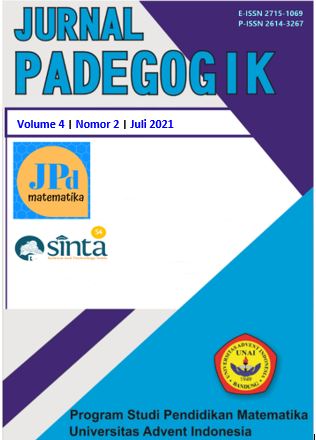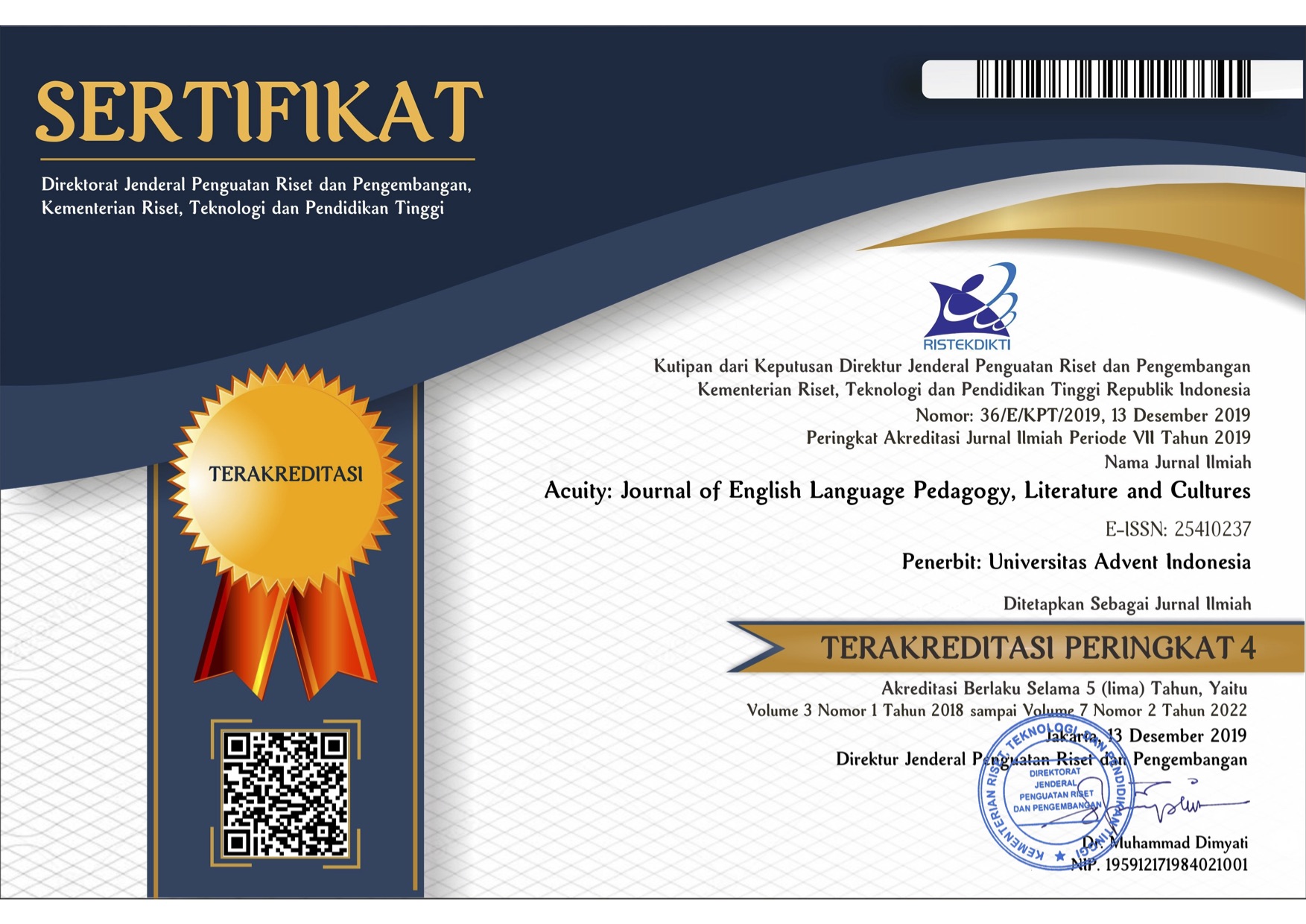ANALYSIS OF MATHEMATICAL CONNECTION ABILITY FOR CLASS VIII STUDENTS REVIEWED FROM REFLECTIVE-IMPULSIVE COGNITIVE STYLE
Keywords:
Mathematical Connection Ability, Reflective-Impulsive Cognitive StyleAbstract
Mathematical connection ability is one of the most important mathematical skills for students. The ability of mathematical connections can be influenced by cognitive styles. One of the cognitive styles reviewed from conceptual tempo is reflective cognitive style and impulsive cognitive style. The purpose of this study was to find out: 1) the most dominant cognitive styles at low, medium, and high levels of mathematical connection ability and 2) analyze and describe the students' mathematical connection abilities in terms of reflective and impulsive cognitive styles. This type of research is descriptive by using qualitative approach. The subjects in this study were 6 students from grade VIII smp Advent Parongpong and grade VIII SMP Advent II Setiabudi selected based on reflective cognitive style and impulsive cognitive style. Data collection method in the form of written tests and interviews. The results showed the most dominant cognitive styles for the low category were impulsive cognitive styles while students with reflective cognitive styles were most dominant for medium and high categories. Reflective students with high mathematical connection ability are able to achieve all indicators of mathematical connection ability. Reflective students with moderate and low mathematical connection skills are less able to achieve all indicators of mathematical connection ability. Impulsive students with high, medium and low mathematical connection skills are less able achieve all indicators of mathematical connection ability.
Downloads
References
Adha, Idul. (2019). Analisis Koneksi Matematis Siswa MTS Kelas VIII Pada Materi
Lingkaran. Palopo: Institusi Agama Islam Negeri (IAIN) Palopo. (Skripsi).
Anggito & Setiawan. (2018). Metodologi Penelitian Kualitatif. Sukabumi: Jejak
Arikunto. (2016). Dasar-Dasar Evaluasi Pendidikan. Jakarta: Bumi Aksara.
Dirgahayu, Hasbi. (2016). Analisis Kemampuan Pemecahan Masalah Matematika Siswa Dengan Model Pembelajaran PBL Ditinjau Dari Gaya Kognitif Pada Materi Prisma dan Limas Kelas VIII. Semarang: Universitas Negeri Semarang. (Skripsi)
Indonesia, Kementrian Pendidikan dan Kebudayaan. (2017). Matematika. Kelas VIII SMP/MTs. Semester 1. Jakarta: Pusat Kurikulum dan Perbukuan, Balitbang, Kemendikbud
Keller J., & Ripoll, Hubert. (2004). Stability of Reflective-Impulsifve Style in Coincidence-Anticipation Motor Tasks. Learning and Individual Differences, Vol.14,219-218.
Kerjasama, M. D., Ratnawati, I. D., Hidayah, I., & Wijayanti, K. (2013). Keefektifan Pembelajaran Matematika Model Learning Cycle 5e Berbantuan Media Mind Mapping Terhadap Kemampuan Koneksi. 733–755.
Lestari & Yudhanegara. (2017). Penelitian Pendidikan Matematika. Bandung: Refika Aditama.
Mahendra, N. R & Mulyono. (2016). Analisis Kemampuan Koneksi Matematis Siswa SMA Ditinjau dari Gaya Kognitif pada Model PBL. 4, 62–71.
Prihastanto & Fitriyani. (2017). Profil Kemampuan Koneksi Matematis Siswa SMP yang Bergaya Kognitif Reflektif-Impulsif Dalam Menyelesaikan Soal Geometri. Jurnal Didaktika, 23(2), 89-98.
Pungkas, P. A. (2016). Analisis Kemampuan Berpikir Kreatif Siswa SMP Kelas VII Berdasarkan Gaya Kognitif Reflektif dan Impulsif Pada Model Anchored Instruction. Semarang: Universitas Negeri Semarang. (Skripsi)
Rahmatina, S., Sumarmo, U., & Johar, R. (n.d.). Tingkat Berpikir Kreatif Siswa dalam Menyelesaikan Masalah Matematika Berdasarkan Gaya Kognitif Reflektif dan Impulsif. 62–70.
Ramdhani, Sendi. (2017). Pembelajaran Matematika Dengan Pendekatan Problem Posing Untuk Meningkatkan Kemampuan Pemecahan Masalah dan Koneksi Matematis Siswa. Bandung: Universitas Pendidikan Indonesia (Skripsi)
Rofiqoh, Zeni. (2015). Analisis Kemampuan Pemecahan Masalah Matematika Siswa Kelas X Dalam Pembelajaran Discovery Learning Berdasarkan Gaya Belajar Siswa. Semarang: Universitas Negeri Semarang. (Skripsi).
Sari, A. S. (2017). Analisis Kemampuan Koneksi Matematika Siswa Pada Materi Teorema Phytagoras Ditinjau Dari Gaya Kognitif. Surakarta: Universitas Muhammadiyah Surakarta. (Skripsi)
Sudirman, Dkk. (2018). Analisis Kemampuan Koneksi Matematis Siswa SMP Pesisir Ditinjau Dari Perbedaan Gender. Jurnal Pembelajaran Berpikir Matematis, Vol 3, No 2. http://ojs.uho.ac.id/index.php/JPBM/article/view/5729
Sugiyono. (2012). Memahami Penelitian Kualitatif. Bandung: Alfabeta.
Warli, W. (2013). Kreativitas Siswa SMP Yang Bergaya Kognitif Reflektif Atau Impulsif Dalam Memecahkan Masalah Geometri. Jurnal Pendidikan Dan Pembelajaran (JPP), Vol. 20 (2), 190–201

Downloads
Published
How to Cite
Issue
Section
License
Copyright (c) 2021 Jurnal Padegogik

This work is licensed under a Creative Commons Attribution-NonCommercial-ShareAlike 4.0 International License.
The submitting author warrants that
- The submission is original and that she/he is the author of the submission together with the named co-authors; to the extend the submission incorporates text passages, figures, data, or other material from the work of others, the submitting author has obtained any necessary permission.
- Articles in this journal are published under the Creative Commons Share-Alike Attribution Licence (CC-BY-SA What does this mean?). This is to get more legal certainty about what readers can do with published articles, and thus a wider dissemination and archiving, which in turn makes publishing with this journal more valuable for you, the authors.
- By submitting an article the author grants to this journal the non-exclusive right to publish it. The author retains the copyright and the publishing rights for his article without any restrictions.







